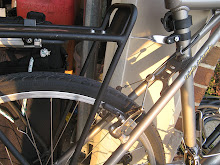I've had a fairly decent Norelco cordless razor for about 4 years, and it's close to giving up the ghost. I haven't replaced the heads - ever - though I've kept them clean, and the battery is not holding a charge anymore.
I'm not very interested in replacing it right away, so I grabbed a package of disposable razors and a can of shaving cream at the supermarket last night. Result: the closest shave I've had in years. But, being an engineer, I can't help over-thinking the decision. So, here's a rough cost/benefit analysis of several forms of keeping my mug from looking like Gandalf's.
First, some notes about my shaving habits. I usually don't until I have to. I sport a goatee, and I don't function well before a shower. Since I'm not usually in contact with customers, I can get away with several days stubble most weeks. The electric razor is nice because I can touch up without using water, but the apparent cost of blade replacements keeps me from doing that regularly, and frankly it's a poor shave. I could spend a big pile of money on a "good" razor, but I don't know how much that would help. Having to remember to shave before I shower is also a bit of a negative, especially on early mornings.
Option 1 - Electric Razor:
- Up Front Cost: about $50 (could be over $200, but we won't go there)
- Replacement blades: about $35/year
- 5-year TCO: $190
- Shave time: fairly slow, to get it as good as possible
- Shave quality: acceptable for daily use
- Pros: dry shave
- Cons: must shave dry skin (i.e. before showering), more often, and bits of hair fly everywhere.
- Environmental Impact: The razor uses a small amount of power from the mains to charge the battery. The battery is recyclable through local battery recycling facilities, but according to Philips Norelco, the rest of the razor is not, except through specialty electronics recycling houses.
Option 2 - Disposable Razor:
- Up Front Cost: about $10 ($7 for razors, $3 for shaving cream)
- Replacement razors: $7 for a pack of 4, average 1 week/razor = $91/year
- 5-year TCO: $455 plus shaving cream
- Shave time: quick!
- Shave quality: good to excellent
- Pros: smooth skin, less time shaving, can (should) shave after shower
- Cons: risk of cuts, disposables in trash, shaving cream mess.
- Environmental Impact: Disposable razors are in theory recyclable, except they suffer the usual problem of having sharp metal blades embedded in (and hard to remove from) the plastic. One could reduce this by cutting the heads off (or by using disposable-head razors at some additional cost), but this increases safety risk. Also there are brands made with recycled plastic that would reduce the impact. However, generally speaking the razors (or at least their blade heads) are landfill material. Note that the shaving cream cans are generally very recyclable steel and plastic.
I made this analysis based on the relatively cheap Gillette Sensor 3 triple-bladed razor, which I picked up in a 4-pack. This blade gives a very good shave over most of my face, with an acceptable job on my neck. In all cases it is better and faster than the electric razor. I'm skeptical how much better a more expensive disposable would be, and quite sure that the far cheaper BIC razors would do well and save some cost.
Option 3 - Classic Safety Razor:
- Up Front Cost: $60-$250 (Razor $50-$240 plus $10/pack for blades
- Replacement blades: $6 for a pack of 10, average 1 week/razor = $32/year
- 5-year TCO: $210 plus shaving cream
- Shave time: quick!
- Shave quality: good to excellent
- Pros: smooth skin, less time shaving, can (should) shave after shower
- Cons: risk of cuts, disposal of blades, shaving cream mess, debatably poorer shave than multi-blade disposable.
- Environmental Impact: The razor itself will last essentially forever, and being made of steel is highly recyclable. The blades, while disposable are also stainless steel and can be recycled.
Bottom Line:
When combining shave quality, cost, convenience and environmental impact, the hands down winner is the old-fashioned safety razor. Its TCO is less expensive than the electric razor and far less than the disposables. Shave quality is much better than the electric and competitive with if not better than the disposables. On convenience, the safety razor matches the disposable and beats the electric on the "can shave after shower" and speed sub-scores. Finally, on environmental impact it's hard to argue with the safety razor. The entire system is 100% recyclable and contains no batteries.
Even better would be a straight razor, but I don't trust myself not to slice off an ear...
The other two have significant drawbacks. Disposables are surprisingly expensive, despite their enticingly low up-front cost, and they generate a mountain of unrecyclable plastic garbage. The electric razor has significantly poorer shave performance, cannot be used well on wet skin, and has a Ni-Cad or Li-Ion battery to recycle.
In the end, it seems, that this is a classic case of "If it ain't broke, don't fix it!" The safety razor was a definite improvement over the straight razor in that it allowed millions of men who were not so dextrous to safely shave their own faces. Big bonus points for convenience, not so good for business at the barber shop. The disposable razor and electric razor were further "improvements" on the safety razor, but given the above analysis it's hard to argue that they truly make any kind of improvement on the original (unless you're a Gillette or Norelco shareholder...).
Now, to find a good old fashioned safety razor...



